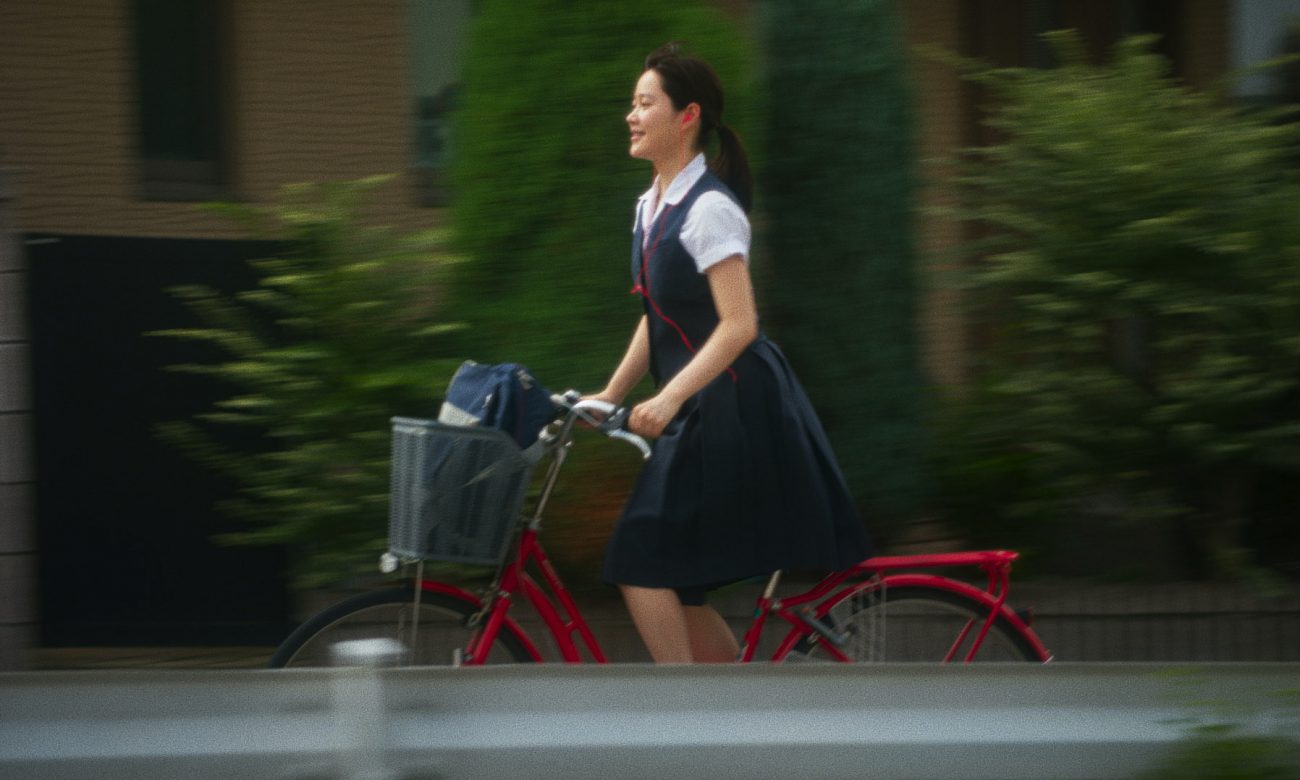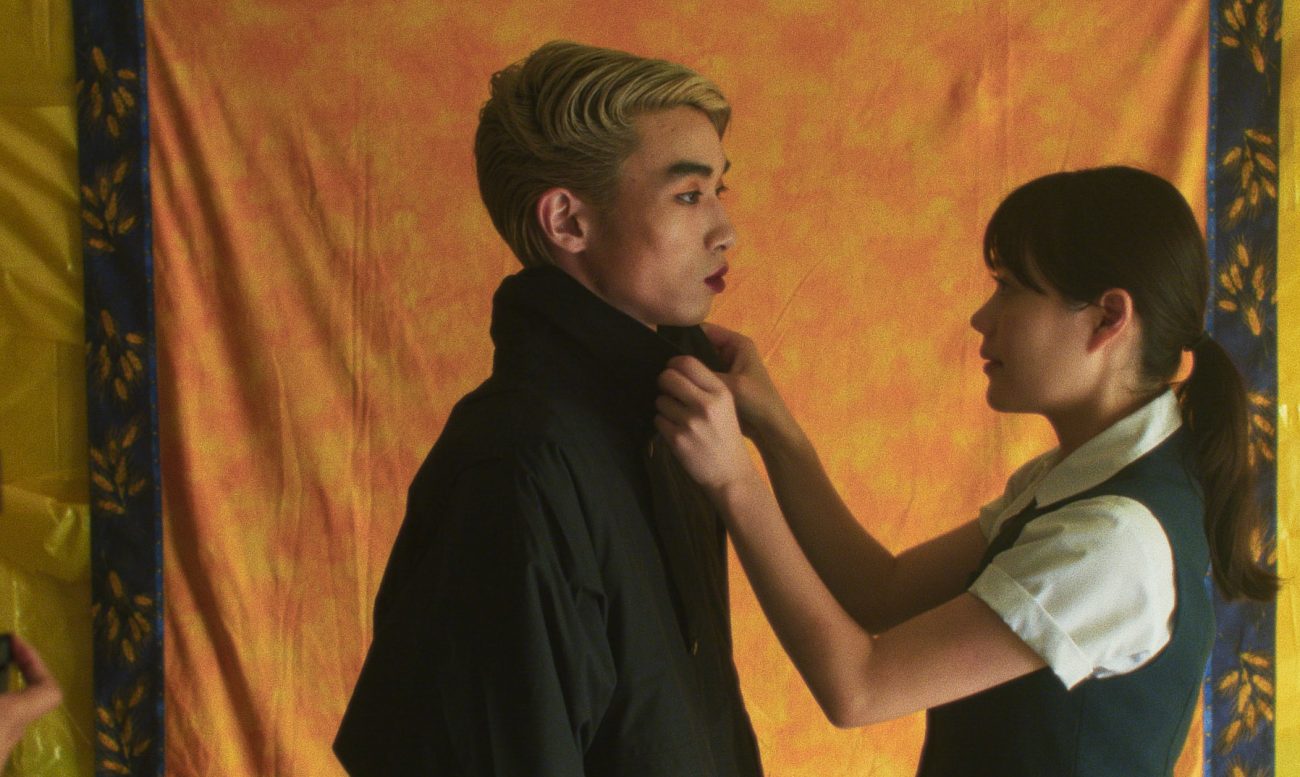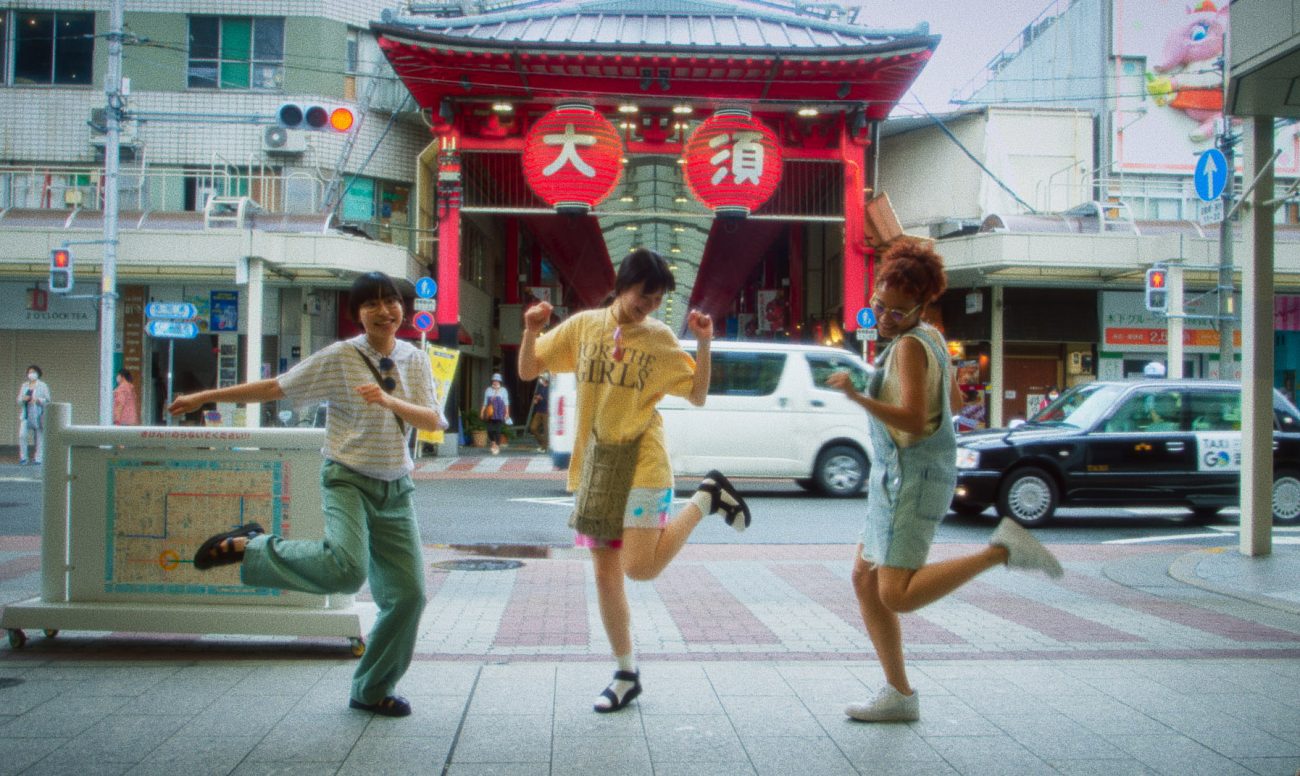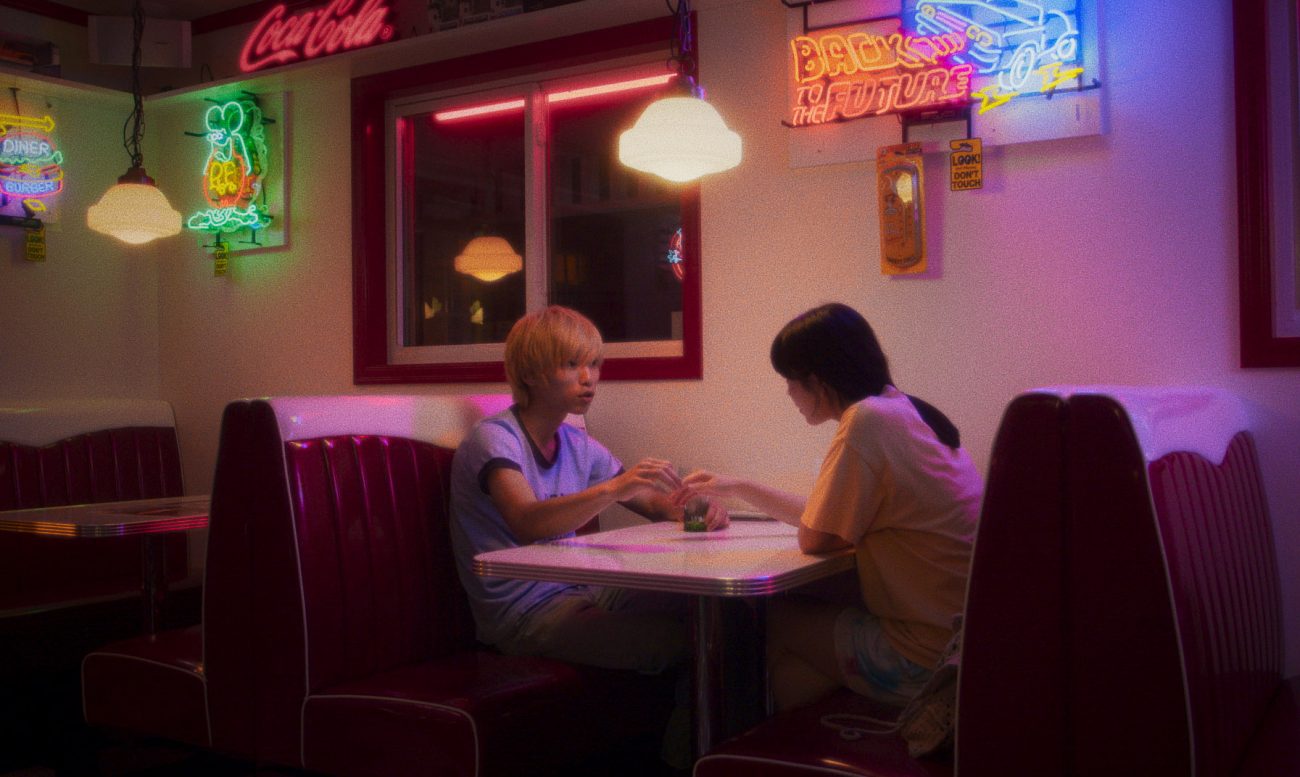Director Daisuke Miyazaki’s films have consistently shown a keen sense of place, music, and soundscapes — a reflection of his deep love for music. His latest film, Plastic, is directly inspired by musician Kensuke Ide’s eclectic concept album Contact from Exne Kedy and The Poltergeists, which imagines the existence of a fictional 70s glam rock band of the same name.

The film follows teenage couple Ibuki (An Ogawa) and Jun (Takuma Fujie), who come together through their shared love of the former band. Growing apart, the young lovers eventually breakup and go on separate paths throughout the COVID-19 pandemic. However, the sudden news of Exne Kedy’s surprise reunion gives new hope to both characters.
Infused with the magic of Kensuke Ide’s incredible music, the film is an offbeat look at what it means to be young and confused, how the bands we love as young people shape us, and a testament to music’s powerful ability to bring people together.
Ahead of its international premiere at Japan Cuts 2023, we spoke to director Daisuke Miyazaki about how glam rock music, his adolescence, and the diversity of Japan’s major cities influenced his latest film Plastic.
I want to start by saying I really enjoyed this film. It’s melancholic but also hopeful. What was your intention in making this film?
This [film] was to record what happened during COVID-19, and what happened afterward. That’s what I wanted to show in this film.
The music in this is incredible. How did the collaboration with artist Kensuke Ide and music producer You Ishihara come about? Did they have any input on the story?
I knew Ide-san, the artist, as we used to hang out together at the music and film distribution company, and I love his music, his album [Contact From Exne Kedy And The Poltergeists by Kensuke Ide With His Mothership], and especially his lyrics. As for their involvement in the story development, because the story was inspired by the lyrics of the album, and I also incorporated my own story, I would say our contribution is 50-50 in terms of the story. As for Ishihara-san, the producer, he is a really legendary music producer since I was in college, so when he joined the film halfway through, it was such an honor and surprise for me that he was able to join in on this project.

Music has always been a big part of your films, starting with hip hop in your film Yamato (California) and now 70s style glam rock in Plastic. You’ve talked about how much you love hip hop before, so why the choice of 70s glam rock this time?
I listen to any kind of music, but if you know 70s glam rock, they really focused on going beyond gender, beyond boundaries, nationalities etc. I felt like these messages really fit the film’s themes well, and this is what I’ve been trying to do with my films as well: going beyond gender and beyond boundaries. So that’s why I chose this genre of music.
Music is also a huge part of youth culture, and I thought maybe that’s why you chose to set this film with young people. I was wondering, how popular is this style of glam rock music with the young people of Japan today?
I have to say, for young people, I don’t think this type of music is very popular at all. It’s only for music enthusiasts, or mostly music nerdy kids. But I made this film, hoping that this [music] would be a trendsetter amongst young people.
I understand that the film has just been released in Japan. How has the reception there been?
The film has just been released in Nagoya this week, and it will be released in Osaka and Tokyo tomorrow [21 July 2023]. Some people have mentioned to me that this is my masterpiece, the best work I’ve ever done, so that was a little unexpected for me.

Speaking of Nagoya, I want to ask about the setting of the film. Nagoya in the beginning of the film seems so nostalgic and charming, while Tokyo is dynamic and exciting, but also alienating. Ibuki says she has many friends there, she stays in a nice apartment, and she even has a boyfriend, but she seems more alone than ever. Places have such distinct characters in your films, from Yamato (California) to Tourism. I don’t know much about Nagoya as a city, so I was wondering what you wanted to show about the two cities?
I actually teach film production at a university in Nagoya, and this university was also the executive producer for this film, so that is kind of why I chose Nagoya. But at the same time, the last film that I did [2019’s Videophobia] was about Osaka, and Nagoya is actually halfway between Osaka and Tokyo. Osaka has a very strong presence and a very strong colour, and so does Tokyo, so you have very strong impressions of both cities. But Nagoya is in the middle, it’s neither [here] nor [there], and that “middleness” fits my character, so that’s why I set the story in Nagoya. Even within Nagoya, I talked about going beyond the boundaries: there are areas in Nagoya that are trying to become more “Tokyo-like”, and [areas that] stay true to what Nagoya is like, so I wanted to compare and contrast these differences even within Nagoya, and also put them next to Tokyo.
Another notable aspect of the film is its structure, and the time skips. Did you always know you wanted it to start in high school and then do several time skips? What did you want to show with the timeskips instead of just focusing on one period of time?
Looking back at my own history, between the ages 17 to 23, my life changed drastically, there was a lot happening, lots of transitions, and lots of changes. Then from 23 to right now, I’m 43, not much has changed. So I was wondering, between those ages of 17 and 23, what caused me to change so much? I wanted to explore that, so I knew going in that I wanted to show that [period of] time, and then the later years.

Western influence and Americana feature heavily in the earlier part of the film: from the American-style diner, vintage clothing shops and the musical fantasy sequences which are very Old Hollywood-like. What was your intention with these sequences?
There are two reasons for this. First is that I lived really close to a US base as a child, and so growing up, American culture “was the best”. But nowadays, Korean culture is more popular. Growing up, I feel as though I am a mixture of Japanese culture, American culture and Chinese culture. Looking at the city of Nagoya, I see a lot of American influences, so that is one reason. The other reason is that rock music originated in the US. The art of film started in France, but really developed in the US. So I thought if I wanted to make a film about rock music, then American culture would have a big presence.
Another very striking thing about this film is the dream-like or surrealist elements. Most of the film is very calm, so this might seem out of place. But paired with the music, it makes a lot of sense. But I was just wondering, what were you thinking when you put these scenes in the film?
In filmmaking, what I place the most focus on is finding a juxtaposition, the moment where something doesn’t quite fit in, where you go “hmm, something is wrong”— the gap, if you will— with the visual or the audio, so that’s how these scenes came about. I had this very striking visual image even when I was writing the script of how this is what I wanted the scenes to look like and sound like, that it shows some kind of displacement, where something that doesn’t quite belong is suddenly there. I felt that if this film gets a cult following, these are the scenes that people would repeatedly show as the scenes that represent the film.
The opening sequence and title is very colourful and trippy. I really like colourful things, so it was very exciting to see and grabbed my attention immediately. How did you come to create this opening title sequence and why?
I made the opening sequence like a music video. I really like mixing up styles and mixing up different kinds of media, but when making a film, I always want to make it “film-like”. However for this part, because of the music, I was going for the music video feel, so that’s how this opening sequence came about.

I want to ask about the two main characters, Ibuki and Jun. They seem very different: Ibuki is very realistic and practical, but also very artistic and idealistic. Meanwhile Jun wants to chase his musical dreams, but has to find a way to make a living. All they have in common is their love for this band, so they seem incompatible. However, as the film goes on, we see that perhaps they are more similar than they think. What did you want to show with these two main characters of Ibuki and Jun and their relationship?
Jun comes to Nagoya from Tokyo, while Ibuki is from Nagoya but goes to Tokyo. They come together at the start when Jun comes to Nagoya, but then they get separated. The more distance they have between them, they start to feel a similar loneliness, if you will. This type of loneliness doesn’t happen just in Japan, I think it is universal, everyone in the world can feel this type of loneliness. This similar feeling of loneliness that grows when they are further apart from each other, that’s what I wanted to show when I was going about making this film.
What are you working on next, and are there any new genres you would love to try, or any actors you would like to work with?
So after I made this film [Plastic], I made another film, a thriller [named] #MITO, which is sort of a sequel to Videophobia, and is about an influencer. But I’ve never done comedy and horror, so that’s what I’m interested in doing next. There’s an actress, Machiko Ono, who appears briefly in Plastic as well, but I’m selfishly hoping that I will be able to get to work with her again in the future.
Plastic is playing as part of Japan Cuts 2023 in New York, running from July 26 – August 6. Filmed in Ether would like to thank director Daisuke Miyazaki, Japan Society and translator Tomoko Takedani Sater for their part in making this interview happen.
